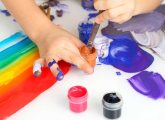Early years settings are particularly complicated places for hand hygiene, but that doesn’t excuse cutting corners, says Dr Carl Edwards…
Germs are everywhere. The average ‘clean-looking’ pair of hands can hold up to 10 million, leaving many of us guilty of passing on the stubborn microbes that can cause illnesses such as colds, influenza, skin infections and food poisoning without realising it. Not only that but failure to cleanse our hands properly after simple tasks like going to the toilet, changing nappies or simply coming into contact with someone who is ill can lead to the spread of serious infections such as MRSA, E.coli and Bird Flu.
Early years settings are particularly complicated places for hand hygiene; playing with toys, handling books and messy play all mean that we end up carrying each other’s germs on our hands.
We use our hands and fingers regularly, without even thinking about it. It’s amazing how many times we touch our faces, rub our eyes, feel and work with our hands throughout the day without giving it a second thought.
For this reason, hand hygiene is incredibly important, because many of the common illnesses we pick up are contracted via our hands and fingernails, for instance, colds and flu, where people usually only think we catch it when people sneeze on us.
Here are some tips on keeping your hands in tip-top hygienic condition that should also help you avoid nasties such as the tummy bugs Norovirus and Campylobacter.
It sounds like such a simple task – and it is, but it’s only effective if you’re doing it correctly! Proper hand-washing requires soap or hand wash and water and should last for at least 15 to 30 seconds. Reciting something such as the alphabet is a good tip to follow to ensure you are washing your hands for long enough. Remember hand-washing works by having the soap and rubbing to make sure the dirt and bacteria are physically removed; you have to be thorough.
Make sure that you are reaching all areas of your hands and not just rubbing the palms together. When handwashing, make sure you include all these areas:
● Palm to palm
● Between the fingers
● Back of the hands
● Base of the thumbs
● Back of the fingers
● Across and under the fingernails
● Around the wrists
The type of soap or handwash does not matter, but it is advisable if using a bar of soap to rinse it before and after use, and you should dry your hands thoroughly after washing them.
Hands should be washed before and after preparing food, attending to a child or someone who is ill. If you wear contact lenses, you should always wash your hands before and after applying the lenses to your eyes.
Fingernails are the worst place for harbouring germs, especially if they are long. One of the main reasons for this is because it’s particularly hard to clean under the fingernails, so the dirt trapped there prevents microbes from being washed away. Using a nail brush and scrubbing your nails daily will help with the build-up of dirt. Lather the brush up with soap and scrub the nails with warm water. Rinse the brush before and after use to keep it clean for the next time you use it. It’s important that it’s allowed to dry out overnight to make sure bacteria don’t build up on it.
Carrying a hand sanitiser when you are out and about, whether on your own or with children, is always a good idea. Even taking it to the shops with you will help protect you from nasty germs on bus hand rails, shopping trolley handles and traffic light buttons.
There are two types of hand sanitiser: those that contain alcohol and those that are alcohol-free. Alcohol-free products are preferable as they don’t dry out the skin; have a long-lasting effect; are non-flammable and are more economical in use, as you don’t have to use as much product for an effective dose; and are safe for use by, and around, children.
EcoHydra produces an antibacterial hand-wash and Antibacterial Alcohol-free foaming hand sanitiser, both of which will kill up to 99.9999% of germs within 15–30 seconds and are gentle on the skin.

“Inspiration is a key part of our pedagogy”
Editors picks
